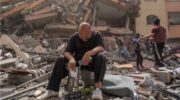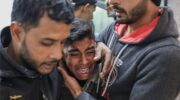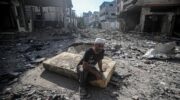Palestinian students following Israeli airstrikes on Gaza City. (Reuters)
Gaza-born Yousef Alhelou offers an insider’s perspective on the siege of Gaza, describing the current situation, as well as Israel’s methods and Palestinians’ state of mind. The ongoing siege imposed on Gaza is the longest in modern history and has had disastrous consequences on all aspects of life. Any truce or ceasefire that does not address lifting the siege and ending the human suffering is doomed to fail… Meanwhile, Netanyahu promises still more attacks on Gaza
by Yousef Alhelou
The new Egyptian mediated ceasefire between Israel and Gaza ended two days of unprecedented military escalation, following Israel’s killing of four Palestinians the preceding day. It was the tenth round of flare-ups and the most dangerous since Israel’s all-out onslaught on Gaza in the summer of 2014. Relentless, massive Israeli air sir strikes and shelling led to the killing of about 30 Palestinians including 2 babies, a child and two pregnant women. Retaliatory long-range projectiles and home-made rockets fired from Gaza into the Israeli side led to the killing of four Israelis.
The latest casualties bring the total number of Palestinians killed since the start of the Great March of Return weekly protests on March 31st 2018 to 293, while the total number of Israelis stands at 6.

Relative calm is being observed for the time being, but both sides expect a new escalation may erupt any time if the root of the tension is not addressed. Palestinians have demanded the lifting of the ongoing 12-year siege in the aftermath of each military escalation, namely the 2008, 2012 and 2014 all-out wars on Gaza.
Soon after the truce went into effect in the early hours of Monday, 6th May 2019, Palestinians went out to inspect the extensive damage and salvage any intact belongings, official documents, valuable items, or even clothing for their children.
Palestinians started their first day of fasting, but many did not break their fasts in their houses. Instead they sat on the ruins and in the middle of the rubble. It’s a grim feeling to become homeless.

According to the authorities in Gaza, 130 residential units were totally destroyed, including high-rise buildings, in addition to 700 units which sustained partial damage.
In the latest round, Israel started its offensive by targeting multi-story residential buildings for a quick win in a disproportionate battle between besieged Gaza and its humble resistance on one side, and Israel and its well equipped army on the other side. This victory is important for Israel ahead of the Eurovision song contest in Tel Aviv on May 14th. Therefore, excessive force was needed to cause a blow to Gazans with extensive devastation, and to try to force the resistance factions to accept Israel’s terms for any ceasefire.
Knock on the roof
Families in Gaza run for cover, as they are often given between five and ten minutes to escape unharmed before their buildings are targeted and leveled to the ground. Israeli intelligence calls a resident of the building, telling him to leave as soon as possible, and to tell others too to flee for their lives. During the call, the intelligence officer can watch the evacuation via a drone image.
Then a small rocket is fired onto the roof of the building as a final warning, followed a short time later by a one-ton missile fired from an F16 Fight jet, flattening the building and reducing it to rubble.
Israel’s stated goal is to target buildings used by members of the resistance groups, however in most cases this claim is denied by the locals. But what is evident is that this policy of collective punishment aims to cause panic, fear, frustration and devastation among the civilian population and trigger them to blame the resistance for this misery and suffering.

Assassination policy
A Hamas commander was assassinated by a drone missile targeting him while he was driving his car in Gaza City. Tel Aviv accused him of being in charge of the financial system of the movement’s armed wing. This was the first assassination since 2014 and was viewed by Hamas as a dangerous escalation against its military and political officials. Israel wanted to send a message that this policy can be resumed if the escalation continues.
Why do ceasefires not last?
Endless ceasefire agreements, or “truces” as they are commonly known by Palestinians, have been reached in recent years, but all collapsed after some time. Three devastating Israeli wars were waged on Gaza in 2008, 2012 and 2014; after each round, Palestinians were expecting to see total lifting of the siege and the sea blockade, but Israel never fulfilled its commitment. Buying time is Netanyahu’s way of forcing Palestinians to accept his conditions, namely to stop arming and building tunnels.
It is crystal clear that the spark that triggered this escalation is Israel’s killing of four Palestinian last Friday, leading gunmen from the Palestinian side to open fire at Israeli troops, injuring two soldiers. But Israel considered this a red line and carried out many air strikes, targeting training sites belonging to the resistance killing 4; in return Palestinian resistance factions retaliated by firing barrages of long-range rockets and projectiles.
Rules of engagement
During Israeli assaults, excessive force is often used under the pretext of self defence against rocket fire from Gaza, with US and European officials stating that Israel has the right to defend itself against attacks from Gaza. For some years now, Tel Aviv has been trying to regain its so-called “power of deterrence,” but Palestinian armed groups have changed rules of engagement. Any Israeli strike or attack is now met with an immediate response, by firing retaliatory projectiles and opening fire at Israeli military targets. This is the new equation now; Israel can no longer dictate its terms.
Psychological warfare
In each flare-up, both sides rely on publishing footage of certain attacks and military operations aimed at raising the spirit of their own people and weakening the morale of their enemy. Social media platforms, mainly Twitter and Facebook, are usually used to disseminate information and leave posts. Videos of air strikes targeting Palestinian residential buildings were shared and circulated on the Israeli army feed, while videos of targeting military troops carriers by Palestinian resistance were filmed and aired.
In one video, a red train was traveling near the targeted armoured carrier, but the chosen target was a military one. That sent a strong a message to the Israelis that Palestinian resistance avoid hitting civilian targets..
Israel’s siege on Gaza the longest siege in modern history
Palestinians say that Israel only understands the language of force and that it cannot stand human and economic losses. On the Palestinian side, the suffering has become part of people’s daily life, as Palestinians have been dehumanized in the eyes of Israel, as if they have no value, with soldiers killing them like sitting ducks across the occupied Palestinian territories.

Gazans have been participating in weekly protests for the past year in order to draw the world’s attention to their plight under Israel’s occupation and siege; they are also calling for the implementation of the right of Palestinian refugees to return to where their grandparents once lived in historic Palestine. Palestinians dream of having a decent, dignified life; they have wishes for a better future, but the military occupation is depriving them of this human basic right.
The ongoing siege imposed on Gaza is the longest in modern history and has had disastrous consequences on all aspects of life. Any truce or ceasefire that does not address the lifting the siege and ending the human suffering is doomed to fail.
Netanyahu: Israel’s military campaign against Gaza is not over
Now as the dust has settled and bombardments have stopped, Israeli PM Netanyahu vowed to crush the Palestinian resistance groups, stating that the military campaign against Gaza is not over yet. A number of Israeli officials expect the new round to start this summer after the end of the Eurovision contest and the Israel’s so-called Independence Day. Palestinians refer to this time as the Nakba, [Catastrophe], which is commemorated on May 15th, marking the loss of their homeland.
It remains to be seen if Israel would fulfill its commitment this time and defuse the tension, or if it would once again flex its muscles and attack Gaza in an attempt to break the will and sprit of the resistance.




